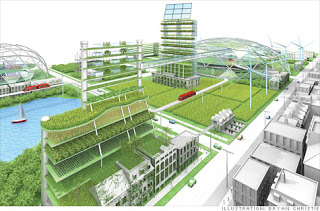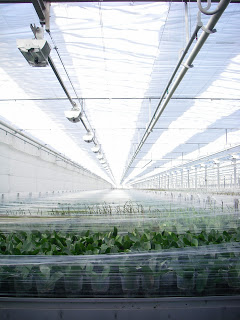
Fortune Magazine post an interesting question?
Can Farming save Detroit?
What do you think? We think Agriculture will go thru many changes as it continues to cope with changing expectations regarding: Sustainability, Climate, Natural Resources and Population.
But, we are not sure that it will save cities…unless that is that the expectations within those cities are greatly different than what they are today.
Please let us know what you think.
Below is what was posted at CNN on Dec 29, 2009.
DETROIT (Fortune) — John Hantz is a wealthy money manager who lives in an older enclave of Detroit where all the houses are grand and not all of them are falling apart. Once a star stockbroker at American Express, he left 13 years ago to found his own firm. Today Hantz Financial Services has 20 offices in Michigan, Ohio, and Georgia, more than 500 employees, and $1.3 billion in assets under management.
Twice divorced, Hantz, 48, lives alone in clubby, paneled splendor, surrounded by early-American landscapes on the walls, an autograph collection that veers from Detroit icons such as Ty Cobb and Henry Ford to Baron von Richthofen and Mussolini, and a set of Ayn Rand first editions.
With a net worth of more than $100 million, he’s one of the richest men left in Detroit — one of the very few in his demographic who stayed put when others were fleeing to Grosse Pointe and Bloomfield Hills. Not long ago, while commuting, he stumbled on a big idea that might help save his dying city.
Every weekday Hantz pulls his Volvo SUV out of the gated driveway of his compound and drives half an hour to his office in Southfield, a northern suburb on the far side of Eight Mile Road. His route takes him through a desolate, postindustrial cityscape — the kind of scene that is shockingly common in Detroit.
Along the way he passes vacant buildings, abandoned homes, and a whole lot of empty land. In some stretches he sees more pheasants than people. “Every year I tell myself it’s going to get better,” says Hantz, bright-eyed, with smooth cheeks and a little boy’s carefully combed haircut, “and every year it doesn’t.”
Then one day about a year and a half ago, Hantz had a revelation. “We need scarcity,” he thought to himself as he drove past block after unoccupied block. “We can’t create opportunities, but we can create scarcity.” And that, he says one afternoon in his living room between puffs on an expensive cigar, “is how I got onto this idea of the farm.”
Yes, a farm. A large-scale, for-profit agricultural enterprise, wholly contained within the city limits of Detroit. Hantz thinks farming could do his city a lot of good: restore big chunks of tax-delinquent, resource-draining urban blight to pastoral productivity; provide decent jobs with benefits; supply local markets and restaurants with fresh produce; attract tourists from all over the world; and — most important of all — stimulate development around the edges as the local land market tilts from stultifying abundance to something more like scarcity and investors move in. Hantz is willing to commit $30 million to the project. He’ll start with a pilot program this spring involving up to 50 acres on Detroit’s east side. “Out of the gates,” he says, “it’ll be the largest urban farm in the world.”
This is possibly not as crazy as it sounds. Granted, the notion of devoting valuable city land to agriculture would be unfathomable in New York, London, or Tokyo. But Detroit is a special case. The city that was once the fourth largest in the country and served as a symbol of America’s industrial might has lately assumed a new role: North American poster child for the global phenomenon of shrinking postindustrial cities.
Nearly 2 million people used to live in Detroit. Fewer than 900,000 remain. Even if, unlikely as it seems, the auto industry were to rebound dramatically and the U.S. economy were to come roaring back tomorrow, no one — not even the proudest civic boosters — imagines that the worst is over. “Detroit will probably be a city of 700,000 people when it’s all said and done,” says Doug Rothwell, CEO of Business Leaders for Michigan. “The big challenge is, What do you do with a population of 700,000 in a geography that can accommodate three times that much?”
But still there’s the problem of what to do with the city’s enormous amount of abandoned land, conservatively estimated at 40 square miles in a sprawling metropolis whose 139-square-mile footprint is easily bigger than San Francisco, Boston, and Manhattan combined. If you let it revert to nature, you abandon all hope of productive use. If you turn it over to parks and recreation, you add costs to an overburdened city government that can’t afford to teach its children, police its streets, or maintain the infrastructure it already has.
Faced with those facts, a growing number of policymakers and urban planners have begun to endorse farming as a solution. Former HUD secretary Henry Cisneros, now chairman of CityView, a private equity firm that invests in urban development, is familiar with Detroit’s land problem. He says he’s in favor of “other uses that engage human beings in their maintenance, such as urban agriculture.” After studying the city’s options at the request of civic leaders, the American Institute of Architects came to this conclusion in a recent report: “Detroit is particularly well suited to become a pioneer in urban agriculture at a commercial scale.”
In that sense, Detroit might actually be ahead of the curve. When Alex Krieger, chairman of the department of urban planning and design at Harvard, imagines what the settled world might look like half a century from now, he sees “a checkerboard pattern” with “more densely urbanized areas, and areas preserved for various purposes such as farming.
The notion of a walled city, a contained city — that’s an 18th-century idea.” And where will the new ideas for the 21st century emerge? From older, decaying cities, Krieger believes, such as New Orleans, St. Louis, Cleveland, Newark, and especially Detroit — cities that have become, at least in part, “kind of empty containers.”
This is a lot to hang on Hantz. Most of what he knows about agriculture he’s picked up over the past 18 months from the experts he’s consulting at Michigan State and the Kellogg Foundation. Then there’s the fact that many of his fellow citizens are openly rooting against him. Since word leaked of his scheme last spring, he has been criticized by community activists, who call the plan a land grab. Opponents have also raised questions about the run-ins he’s had with regulators at Hantz Financial.
But Detroit is nothing if not desperate for new ideas, and Hantz has had no trouble getting his heard. “It all sounds very exciting,” says the DEGC’s Jackson, whose agency is working on assembling a package of incentives for Hantz, including free city land. “We hope it works.”
Detroit’s civic history is notable for repeated failed attempts to revitalize its core. Over the past three decades leaders have embraced a series of downtown redevelopment plans that promised to save the city.
The massive Renaissance Center office and retail complex, built in the 1970s, mostly served to suck tenants out of other downtown buildings. (Today 48 of those buildings stand empty.) Three new casinos (one already bankrupt) and two new sports arenas (one for the NFL’s dreadful Lions, the other for MLB’s Tigers) have restored, on some nights, a little spark to downtown Detroit but have inspired little in the way of peripheral development. Downtown is still eerily underpopulated, the tax base is still crumbling, and people are still leaving. The jobless rate in the city is 27%.
Nothing yet tried in Detroit even begins to address the fundamental issue of emptiness — empty factories, empty office buildings, empty houses, and above all, empty lots. Rampant arson, culminating in the annual frenzy of Devil’s Night, is partly to blame. But there has also been a lot of officially sanctioned demolition in Detroit. As white residents fled to the suburbs over the decades, houses in the decaying neighborhoods they left behind were often bulldozed.
Abandonment is an infrastructure problem, when you consider the cost of maintaining far-flung roads and sewer systems; it’s a city services problem, when you think about the inefficiencies of collecting trash and fighting crime in sparsely populated neighborhoods; and it’s a real estate problem. Houses in Detroit are selling for an average of $15,000.
That sounds like a buying opportunity, and in fact Detroit looks pretty good right now to a young artist or entrepreneur who can’t afford anyplace else — but not yet to an investor. The smart money sees no point in buying as long as fresh inventory keeps flooding the market. “In the target sites we have,” says Hantz, “we [reevaluate] every two weeks.”
As Hantz began thinking about ways to absorb some of that inventory, what he imagined, he says, was a glacier: one broad, continuous swath of farmland, growing acre by acre, year by year, until it had overrun enough territory to raise the scarcity alarm and impel other investors to act. Rick Foster, an executive at the Kellogg Foundation whom Hantz sought out for advice, nudged him gently in a different direction.
“I think you should make pods,” Foster said, meaning not one farm but many. Hantz was taken right away with the concept of creating several pods — or lakes, as he came to think of them — each as large as 300 acres, and each surrounded by its own valuable frontage. “What if we had seven lakes in the city?” he wondered. “Would people develop around those lakes?”
To increase the odds that they will, Hantz plans on making his farms both visually stunning and technologically cutting edge. Where there are row crops, Hantz says, they’ll be neatly organized, planted in “dead-straight lines — they may even be in a design.” But the plan isn’t to make Detroit look like Iowa. “Don’t think a farm with tractors,” says Hantz. “That’s old.”
In fact, Hantz’s operation will bear little resemblance to a traditional farm. Mike Score, who recently left Michigan State’s agricultural extension program to join Hantz Farms as president, has written a business plan that calls for the deployment of the latest in farm technology, from compost-heated greenhouses to hydroponic (water only, no soil) and aeroponic (air only) growing systems designed to maximize productivity in cramped settings.
He’s really excited about apples. Hantz Farms will use a trellised system that’s compact, highly efficient, and tourist-friendly. It won’t be like apple picking in Massachusetts, and that’s the point. Score wants visitors to Hantz Farms to see that agriculture is not just something that takes place in the countryside. They will be able to “walk down the row pushing a baby stroller,” he promises.
Crop selection will depend on the soil conditions of the plots that Hantz acquires. Experts insist that most of the land is not irretrievably toxic. The majority of the lots now vacant in Detroit were residential, not industrial; the biggest problem is how compacted the soil is. For the most part the farms will focus on high-margin edibles: peaches, berries, plums, nectarines, and exotic greens. Score says that the first crops are likely to be lettuce and heirloom tomatoes.
Hantz says he’s willing to put up the entire $30 million investment himself — all cash, no debt — and immediately begin hiring locally for full-time positions. But he wants two things first from Jackson at the DEGC: free tax-delinquent land, which he’ll combine with his own purchases, he says (he’s aiming for an average cost of $3,000 per acre, in line with rural farmland in southern Michigan), and a zoning adjustment that would create a new, lower tax rate for agriculture. There’s no deal yet, but neither request strikes Jackson as unattainable. “If we have reasonable due diligence,” he says, “I think we’ll give it a shot.”
Detroit mayor Dave Bing is watching closely. The Pistons Hall of Fame guard turned entrepreneur has had what his spokesman describes as “productive discussions” with Hantz. In a statement to Fortune, Bing says he’s “encouraged by the proposals to bring commercial farming back to Detroit. As we look to diversify our economy, commercial farming has some real potential for job growth and rebuilding our tax base.”
Hantz, for his part, says he’s got three or four locations all picked out (“one of them will pop”) and is confident he’ll have seeds in the ground “in some sort of demonstration capacity” this spring. “Some things you’ve got to see in order to believe,” he says, waving his cigar. “This is a thing you’ve got to believe in order to see.”
Many have a hard time making that leap. When news of Hantz’s ambitious plan broke in the Detroit papers last spring, few people even knew who he was. A little digging turned up a less-than-spotless record at Hantz Financial Services. The firm has paid fines totaling more than $1 million in the past five years, including $675,000 in 2005, without admitting or denying guilt, “for fraud and misrepresentations relating to undisclosed revenue-sharing arrangements, as well as other violations,” according to the Financial Industry Regulatory Authority. (Hantz responds, “If we find something that isn’t in compliance, we take immediate steps to correct the problem.”)
Hantz Farms’ first hire, VP Matt Allen, did have an established reputation in Detroit, but it wasn’t a good one. Two years ago, while he was press secretary for former Detroit mayor Kwame Kilpatrick, Allen pleaded guilty to domestic violence and obstructing police after his wife called 911. He was sentenced to a year’s probation. Hantz says he has known Allen for many years and values his deep knowledge of the city. “He has earned a second chance, and I’m willing to give it to him,” he says.
Some of Hantz’s biggest skeptics, ironically, are the same people who’ve been working to transform Detroit into a laboratory for urban farming for years, albeit on a much smaller scale. The nonprofit Detroit Agriculture Network counts nearly 900 urban gardens within the city limits. That’s a twofold increase in two years, and it places Detroit at the forefront of a vibrant national movement to grow more food locally and lessen the nation’s dependence on Big Ag.
None of those gardens is very big (average size: 0.25 acre), and they don’t generate a lot of cash (most don’t even try), but otherwise they’re great: as antidotes to urban blight; sources of healthy, affordable food in a city that, incredibly, has no chain supermarkets; providers of meaningful, if generally unpaid, work to the chronically unemployed; and beacons around which disintegrating communities can begin to regather themselves.
That actually sounds a lot like what Hantz envisions his farms to be in the for-profit arena. But he doesn’t have many fans among the community gardeners, who feel that Hantz is using his money and connections to capitalize on their pioneering work. “I’m concerned about the corporate takeover of the urban agriculture movement in Detroit,” says Malik Yakini, a charter school principal and founder of the Detroit Black Community Food Security Network, which operates D-Town Farm on Detroit’s west side. “At this point the key players with him seem to be all white men in a city that’s at least 82% black.”
Hantz, meanwhile, has no patience for what he calls “fear-based” criticism. He has a hard time concealing his contempt for the nonprofit sector generally. (“Someone must pay taxes,” he sniffs.) He also flatly rejects the idea that he’s orchestrating some kind of underhanded land grab. In fact, Hantz says that he welcomes others who might want to start their own farms in the city. “Viability and sustainability to me are all that matters,” he says.
And yet Hantz is fully aware of the potentially historic scope of what he is proposing. After all, he’s talking about accumulating hundreds, perhaps even thousands, of acres inside a major American city. And it’s clear that he views Hantz Farms as his legacy. Already he’s told his 21-year-old daughter, Lauren, his only heir, that if she wants to own the land one day, she has to promise him she’ll never sell it. “This is like buying a penthouse in New York in 1940,” Hantz says. “No one should be able to afford to do this ever again.”
That might seem like an overly optimistic view of Detroit’s future. But allow Hantz to dream a little. Twenty years from now, when people come to the city and have a drink at the bar at the top of the Renaissance Center, what will they see? Maybe that’s not the right vantage point. Maybe they’ll actually be on the farm, picking apples, looking up at the RenCen. “That’s the beauty of being down and out,” says Hantz. “You can actually open your mind to ideas that you would never otherwise embrace.” At this point, Detroit doesn’t have much left to lose. 
Visit our corporate website at https://hortamericas.com






















